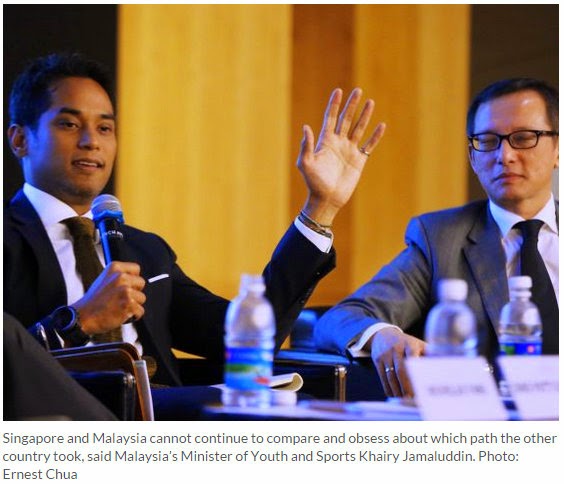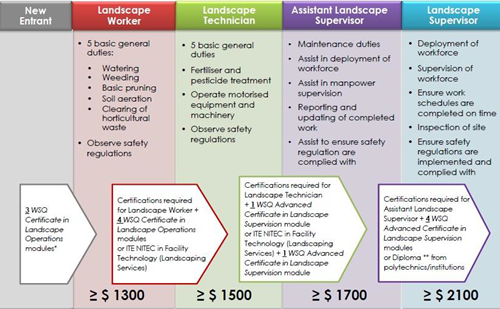Malaysian minister says the two need each other, and must forget their 'big brother, little brother past'
By Reme Ahmad, Assistant Money Editor, The Straits Times, 24 Apr 2015
By Reme Ahmad, Assistant Money Editor, The Straits Times, 24 Apr 2015
MALAYSIAN Cabinet Minister Khairy Jamaluddin yesterday called on Malaysia and Singapore to move beyond treating each other as bogeymen and rivals and instead come together as equals to improve ASEAN.
He said that in the past five decades, politicians have used the other country to show how much progress had been made in their own nation, but this "abang, adik" (big brother, little brother) relationship should be a thing of the past.
The Youth and Sports Minister pointed out that Malaysia and Singapore are inextricably linked by deep trade ties, and already work closely together on security issues such as counter-terrorism, intelligence sharing and defence exercises.
"For many, many years, in the last 50 years, we have existed with this world view, as counterpoint to one another. If you read speeches made by Malaysian politicians, every time they need to rally nationalism, there is only one bogeyman, and the most convenient, of course, is Singapore.
"If you read the writings of Mr Lee Kuan Yew, it is very clear who the rival is.
"I think it's time we accepted the fact that we need each other, and we put aside this world view that we use each other for our national interests," Mr Khairy said in response to a question at a forum held in Singapore.
Mr Khairy and former Indonesian deputy foreign minister Dino Pati Djalal were the speakers at Connecting Singapore And Our Neighbours: Competition, Cooperation And Integration.
The event was organised by the Singapore Institute of International Affairs (SIIA).
Speaking as commentator at the forum, SIIA chairman Simon Tay said his father's generation of Singaporeans and Malaysians often compared happenings in the two countries.
"I share the hope that we get rid of some of the old baggage and work together in a new way," he said.
Mr Khairy said the challenges faced by Malaysia and Singapore are the same today.
"It's about collaboration... It's no more this condescending relationship on both sides.
"It's no longer who is the big brother, who is the little brother, who is the abang, who is the adik. We are all friends now and we are all equal; we want to see ASEAN work."
Mr Khairy defended the affirmative action Bumiputera policy, which is often attacked by Malaysia's critics, saying it helped Malays break out of poverty to make the country peaceful and stable.
Asked about the attacks on Prime Minister Najib Razak by former prime minister Mahathir Mohamad, Mr Khairy said the Cabinet and Umno leaders will answer the issues raised in detail.These include the attacks over finances of government-backed fund 1Malaysia Development Berhad, with an audit being carried out by the respected auditor-general.
"We have to tackle the substance of his criticisms," Mr Khairy said.
Dr Djalal, in his speech, said that Indonesia has had a "golden decade" under the two-term president Susilo Bambang Yudhoyono, who raised the level of economic activities, strengthened national identity and boosted the country's self-esteem.
President Joko Widodo must now meet the high expectations of Indonesians to bring in the "second golden decade", Dr Djalal said.
While there have been concerns raised about increasing Indonesian nationalism, the former Indonesian minister sees instead a country that is more outward-looking than before.
"Maybe there is a change in style and emphasis, but ASEAN is the cornerstone of our policy," he said.
Malaysia still keen on replacing Causeway: Khairy
Structure ‘important symbol’ for bilateral relations, different from Dr M’s ‘crooked bridge’
Structure ‘important symbol’ for bilateral relations, different from Dr M’s ‘crooked bridge’
By Neo Chai Chin, TODAY, 24 Apr 2015
Malaysia remains keen on the prospect of a new bridge replacing the Causeway, and Malaysian Minister for Youth and Sports Khairy Jamaluddin said he hoped the Prime Ministers of both countries will discuss the issue at the leaders’ retreat in 10 days’ time.
A new bridge would be a symbol for future bilateral relations, said Mr Khairy at a media interview before a talk on Singapore’s need to balance relations with its neighbours. The talk was organised by think tank Singapore Institute of International Affairs (SIIA) yesterday.
Malaysia remains keen on the prospect of a new bridge replacing the Causeway, and Malaysian Minister for Youth and Sports Khairy Jamaluddin said he hoped the Prime Ministers of both countries will discuss the issue at the leaders’ retreat in 10 days’ time.
A new bridge would be a symbol for future bilateral relations, said Mr Khairy at a media interview before a talk on Singapore’s need to balance relations with its neighbours. The talk was organised by think tank Singapore Institute of International Affairs (SIIA) yesterday.
“I think it’s an important symbol as well for future bilateral relations, that we’re no longer trapped by the whole notion of having to have that Causeway — we can demolish it and build something,” he said.
“And before we even talk about a rapid transit system between Johor and Singapore and the high-speed rail link, I think we should explore the possibility of whether we can have a bridge. It’ll be nice and I’m sure on both sides they’ll be happy to have the water flow through the Straits,” he added.
Mr Khairy said a new bridge could provide a wider thoroughfare between Singapore and Malaysia, potentially reducing jams. But he was clear that the current Malaysian government is not pursuing the idea of the “crooked bridge” mooted by former Malaysian Prime Minister Mahathir Mohamad.
The “crooked bridge” project involves tearing down Malaysia’s side of the Causeway and replacing it with a six-lane bridge connected to Singapore. The Republic had opposed the work, arguing that it would be a costly affair that would bring few economic benefits.
The Causeway is jointly owned by both countries, and “if you want to replace the Causeway, you should replace it with a straight bridge where there’s agreement on both sides”, said Mr Khairy. He added that Malaysian Prime Minister Najib Razak has raised the issue of a new bridge with his counterpart, Singapore’s Prime Minister Lee Hsien Loong.
The crooked bridge is one of the issues recently raised by Dr Mahathir against Mr Najib. Asked about Dr Mahathir’s criticisms of Mr Najib and whether this has affected investor confidence in his country, Mr Khairy pointed to the oversubscription of the Malaysian government’s US$1.5 billion Islamic bonds by six times.
Mr Najib has the backing of the Malaysian Cabinet and the ruling party’s senior leadership, he said. Mr Najib has met with the women’s wing, youth wing, young women’s wing as well as the division chiefs of United Malays National Organisation (UMNO), the ruling party. “We’ve all given our support to the Prime Minister and party president,” said Mr Khairy, chairman of UMNO’s youth wing.
He noted that every administration faces challenges, and that Dr Mahathir had also attacked former Malaysian Prime Minister Abdullah Badawi.
The Cabinet decided not to respond to criticisms of a personal nature, but to address in detail matters of public interest, such as allegations about the government-owned investment firm 1Malaysia Development Bhd.
“I think people have been fed a lot of allegations in great detail, so we really have to ensure that each and every allegation is answered in a comprehensive way. That’s why we’ve asked for a (comprehensive) audit to be done ... on all the allegations from the PetroSaudi deal, to how the liabilities have accumulated,” said Mr Khairy.
The audit will make its way to Parliament and to the public accounts committee made up of opposition and government lawmakers. Mr Najib has said he would make sure that anyone found to have embezzled or committed criminal breach of trust would be punished, said Mr Khairy.
Asked about his interest in taking the reins as Prime Minister, Mr Khairy said: “Not at all, none of us are trained and brought up in the party to be interested in the top job. We’re just interested in playing our part.”
Meanwhile, issues on ASEAN identity, geo-political rivalry between China and the United States, nationalism in Indonesia and Singapore-Malaysia ties going forward were discussed at the SIIA’s talk titled Future50: Connecting Singapore And Our Neighbours.
Mr Khairy was joined by former Indonesian Vice-Minister for Foreign Affairs Dino Patti Djalal. SIIA’s executive director Nicholas Fang moderated and SIIA chairman Simon Tay provided additional comments.
In his opening remarks, Mr Khairy spoke on the need for bilateral relations to “move forward”. “We cannot continue to exist as a counterpoint to one another,” he said. “I think there is an excessive juxtaposition in Malaysia of where we are , and where Singapore is, vis-a-vis the other.
In his opening remarks, Mr Khairy spoke on the need for bilateral relations to “move forward”. “We cannot continue to exist as a counterpoint to one another,” he said. “I think there is an excessive juxtaposition in Malaysia of where we are , and where Singapore is, vis-a-vis the other.
“The choices we have made respectively in terms of structuring our economies and our society, we cannot compare and we cannot continue to obsess about which path the other one took,” he added. “One, it sometimes comes across as condescending, but it also continues to internalise an ‘us and them’ world view between Singapore and Malaysia.”
















